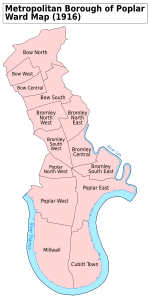Poplar South (UK Parliament constituency) facts for kids
Quick facts for kids {{{Name}}}[[{{{Type}}} constituency]] |
|
|---|---|
| [[Image:{{{Map1}}}Constituency.svg|120px|]] [[Image:England{{{Map2}}}.svg|120px|]] |
|
| {{{Name}}} shown within [[{{{Entity}}}]], and {{{Entity}}} shown within England | |
| Created: | {{{Year}}} |
| MP: | {{{MP}}} |
| Party: | {{{Party}}} |
| Type: | House of Commons |
| County: | [[{{{County}}}]] |
| EP constituency: | [[{{{EP}}} (European Parliament constituency)|{{{EP}}}]] |
South Poplar was a special area in the East End of London that had its own representative, called a Member of Parliament (MP), in the UK Parliament. An MP is someone elected by the people to speak for them in the government.
This area was created as a "parliamentary constituency" for the 1918 general election. It was then removed for the 1950 general election. After that, a new area called Poplar largely took its place.
Contents
Where Was South Poplar?
The South Poplar area included several smaller parts of the Poplar district. These parts were known as wards: Bromley Central, Bromley South East, Poplar Cubitt Town, Poplar East, Poplar Millwall, Poplar North West, and Poplar West.
Who Represented South Poplar?
The people of South Poplar elected one Member of Parliament (MP) to represent them in the UK Parliament. Here are the MPs who served South Poplar:
| Election | Member | Party | |
|---|---|---|---|
| 1918 | Alfred Yeo | Liberal | |
| 1922 | Samuel March | Labour | |
| 1931 | David Adams | Labour | |
| 1942 by-election | William Guy | Labour | |
| 1950 | constituency abolished: see Poplar | ||
How Elections Worked in South Poplar
Elections are how people choose their representatives. In South Poplar, elections were held regularly to decide who would be their MP.
The First Election: 1918
The very first election for South Poplar was in 1918. Alfred Yeo from the Liberal Party won this election. He received more votes than the other candidates.
A Change in Representation: 1922
In the 1922 general election, the people of South Poplar elected a new MP. Samuel March from the Labour Party won this time. This showed a shift in which political party the area supported.
Labour Party Holds the Seat
After 1922, the Labour Party continued to win the elections in South Poplar. Samuel March was re-elected several times. When he passed away, David Adams became the MP in 1931. Later, in 1942, William Guy became the MP after a special election called a "by-election." The Labour Party held the seat until the South Poplar constituency was abolished in 1950.
Images for kids



